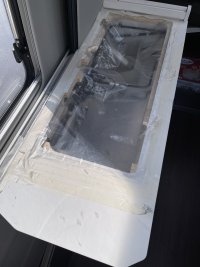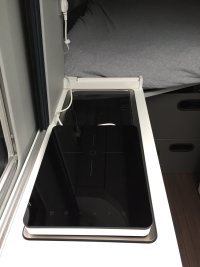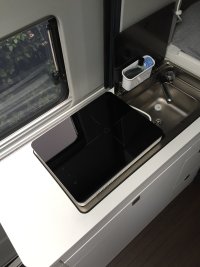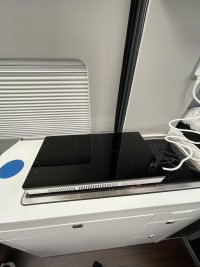You are using an out of date browser. It may not display this or other websites correctly.
You should upgrade or use an alternative browser.
You should upgrade or use an alternative browser.
T
T3Z-GB
Guest User
Iv gone all out on the electrical upgrade.
Attached pic… iv still yet to tidy it up a little,
and give the full schematics as promised, iv just been to busy.
In the meantime the van is now mostly electric apart from the cooktop, Waiting on a price to remove the gas burner sink combo and replace it with a induction top. After that the gas will be removed.
And then reconnect back to the consumer unit.
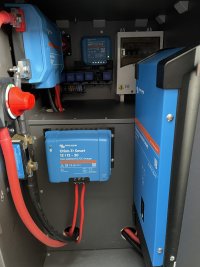
Attached pic… iv still yet to tidy it up a little,
and give the full schematics as promised, iv just been to busy.
In the meantime the van is now mostly electric apart from the cooktop, Waiting on a price to remove the gas burner sink combo and replace it with a induction top. After that the gas will be removed.
And then reconnect back to the consumer unit.

T
T3Z-GB
Guest User
D
dominichayhoe
Overthinking it because I don’t agree with you, maybe.What issues are you expecting? You appear to be overthinking it.
It’s no different to the ocean having a battery at the front & back.
Put a large cube fuse on the back +ve connection if you are worried about overloading anything.
My point is, the cabling was not installed with the intention of charging a battery. A fuse is not going to help that.
It is completely different to a van purpose built with batteries in those locations.
andyinluton
Super Poster
VIP Member
- Messages
- 7,739
- Vehicle
- T6.1 Ocean 204 4 motion
What is it that you don’t agree with?Overthinking it because I don’t agree with you, maybe.
My point is, the cabling was not installed with the intention of charging a battery. A fuse is not going to help that.
It is completely different to a van purpose built with batteries in those locations.
There isn’t special cable made for charging batteries - any cable of a big enough size will do.
Why do you think it is any different to a purpose built van with the batteries in those locations ie an Ocean?
It’s simple basic electrics, when it comes to connecting two batteries together there aren’t a huge number of ways to do it.
Y
yossarian
Top Poster
Lifetime VIP Member
I guess potentially one has doubled the current sinking capability of the battery and could potentially overload the alternator.
I suspect that a modern alternator has some sort of primitive current limiting controlled by the regulator. If you are concerned fuse the connection appropriately and make sure you can detect a blown fuse without ruining your holiday.
The ocean is available with different size alternators and batteries and I've not seen different allowances on the diagrams. Which suggests the alternator will current limit itself.
I suspect that a modern alternator has some sort of primitive current limiting controlled by the regulator. If you are concerned fuse the connection appropriately and make sure you can detect a blown fuse without ruining your holiday.
The ocean is available with different size alternators and batteries and I've not seen different allowances on the diagrams. Which suggests the alternator will current limit itself.
A
andy_c
AFAIC this set up forces the installation of an identical battery to the original leisure battery - same size, same age, same chemistry, same charge / discharge characteristics. I’m not too confident in charging through 1+2 for the reasons others have raised but perhaps it’s fine. Regardless, I’ve concluded I’ll put a dc-dc charger in so I can go with a larger deep cycle AGM battery and then in the future maybe a lithium. I’ll update on the install over the next week or so.What pitfalls?
A
andy_c
Nice @T3Z-GB! Which batteries have you gone for and where are they located?Iv gone all out on the electrical upgrade.
Attached pic… iv still yet to tidy it up a little,
and give the full schematics as promised, iv just been to busy.
In the meantime the van is now mostly electric apart from the cooktop, Waiting on a price to remove the gas burner sink combo and replace it with a induction top. After that the gas will be removed.
And then reconnect back to the consumer unit.
View attachment 90807
andyinluton
Super Poster
VIP Member
- Messages
- 7,739
- Vehicle
- T6.1 Ocean 204 4 motion
AFAIC this set up forces the installation of an identical battery to the original leisure battery - same size, same age, same chemistry, same charge / discharge characteristics. I’m not too confident in charging through 1+2 for the reasons others have raised but perhaps it’s fine. Regardless, I’ve concluded I’ll put a dc-dc charger in so I can go with a larger deep cycle AGM battery and then in the future maybe a lithium. I’ll update on the install over the next week or so.
The intention is to use the same battery front & back.
No one has actually said what their concern are about charging - the "switch" is a heavy duty isolator designed to carry large currents its not really any different to the factory fitted switch apart from having more terminals that makes it easier to do the connections. .
The only time you could conceivably have a problem is at the time of initial connection the batteries were at vastly different state of charge, there could be a rush of current at the point of connection, this is a one off at the time of installation & can be avoided by just making sure both batteries are at a similar state before fitting.
You realise that in your set up you will still end up with the charging going through the same switch & the current going through exactly the same front to rear cables?
I presume you are going to be ditching your under bonnet battery in this set up - I would be happy to buy it off you as it should be a perfect match for mine.
Buying a larger AGM battery seems a complete waste of money you might as well go straight to Lithium
T
T3Z-GB
Guest User
Thanks Andy,Nice @T3Z-GB! Which batteries have you gone for and where are they located?
I went with victron, I have one 200ah smart lithium with the Small BMS, fancied everything blue
I went with victron batteries due to nothing else being available on the market in that size range that you can continuously draw 400ah from a single 200ah battery. Obviously 800ah continuous with the 2x200ah. Thinking about the wattage, that’s 10,240 watts peak.. way overboard, but more then enough to feed the hungry inverter.
The battery is in the next door cupboard, the second will go there to. I’ve a shelf to separate the battery bank below from packing space above.
will post more pics once they connected.
D
dominichayhoe
The fact you clearly don’t understand is what would worry me. Im not going to explain it to you.What is it that you don’t agree with?
There isn’t special cable made for charging batteries - any cable of a big enough size will do.
Why do you think it is any different to a purpose built van with the batteries in those locations ie an Ocean?
It’s simple basic electrics, when it comes to connecting two batteries together there aren’t a huge number of ways to do it.
Feel free though, do install one and use it extensively. Then in 12 months time if your van is still in one piece you’ll have let anyone know who’s interested in doing this that the van’s wiring can take it.
I wish you good luck with your endeavour.
Last edited:
andyinluton
Super Poster
VIP Member
- Messages
- 7,739
- Vehicle
- T6.1 Ocean 204 4 motion
That’s not really helpful is it.
We have the German board where this originated from with thousands of views and six pages of discussion without a single person being able to see anything wrong with it.
Then we have this board where you think it won’t work but won’t explain why because you think I won’t understand.
This coming from someone in an earlier post was talking about “be sure that adding the extra battery will mean it still runs to the van back through the intended route I.e consumer unit” demonstrating a dangerous lack of knowledge.
We have the German board where this originated from with thousands of views and six pages of discussion without a single person being able to see anything wrong with it.
Then we have this board where you think it won’t work but won’t explain why because you think I won’t understand.
This coming from someone in an earlier post was talking about “be sure that adding the extra battery will mean it still runs to the van back through the intended route I.e consumer unit” demonstrating a dangerous lack of knowledge.
T
The Yorkshireman
T
T3Z-GB
Guest User
Yeah saw that, £49 was really tempted. How do you find cooking on it. Does it have a proper variable heat setting? in other words not switching on and off to maintain heat etc.
T
The Yorkshireman
It’s works ok for us;
You can quickly start cooking since the hob easily plugs in with the included plug.
Induction hobs are extremely energy efficient, fast and precise as induction technology transfers energy directly into magnetic cookware.
The touch/press control panel allows you to regulate the heat easily and precisely by just touching the + and – symbols.
Always put the hob on a flat, stable surface when using it.
Hob with induction cooking zone: 1x175 mm.
1x2000W induction zone.
Connection rating: 2000W.
Current: 10A.
Voltage: 220-240V.
Product details
Perfect for the smaller kitchen or wherever you need an extra cooking zone.You can quickly start cooking since the hob easily plugs in with the included plug.
Induction hobs are extremely energy efficient, fast and precise as induction technology transfers energy directly into magnetic cookware.
The touch/press control panel allows you to regulate the heat easily and precisely by just touching the + and – symbols.
Always put the hob on a flat, stable surface when using it.
Hob with induction cooking zone: 1x175 mm.
1x2000W induction zone.
Connection rating: 2000W.
Current: 10A.
Voltage: 220-240V.
T
The Yorkshireman
Don’t forget to add on all the extra things you will buy that you never new you needed!It’s works ok for us;
Product details
Perfect for the smaller kitchen or wherever you need an extra cooking zone.
You can quickly start cooking since the hob easily plugs in with the included plug.
Induction hobs are extremely energy efficient, fast and precise as induction technology transfers energy directly into magnetic cookware.
The touch/press control panel allows you to regulate the heat easily and precisely by just touching the + and – symbols.
Always put the hob on a flat, stable surface when using it.
Hob with induction cooking zone: 1x175 mm.
1x2000W induction zone.
Connection rating: 2000W.
Current: 10A.
Voltage: 220-240V.
T
T3Z-GB
Guest User
D
dominichayhoe
A Jackery won't run that at the rated spec, the inverter of the top model is only 1800w.For anyone frightened of torching their van because they haven’t a clue about messing with the electrics here’s our alternative hob.
If you want to park up in some remote spot or car park you will need a Jackery!
IKEA cheap as chips
View attachment 90935
View attachment 90936
I've tested my 1kw one burst on mine and it lasts a very short time at 1500w.
Can you run it on low and test the draw? You'd have to be careful not to damage the jackery.
Mr T
Chris
Super Poster
Lifetime VIP Member
So, getting back on topic, is anyone able to offer some fact/calculation based input as to whether the addition of a 2nd AGM battery will cause issues?
As @andyinluton has already said, this has been carried out by many German forum owners (several months ago) with no reports of issues, and no one raised concerns. I am genuinely interested to understand what the potential issues are with this. Please be friendly and supportive!
As @andyinluton has already said, this has been carried out by many German forum owners (several months ago) with no reports of issues, and no one raised concerns. I am genuinely interested to understand what the potential issues are with this. Please be friendly and supportive!
Eber123
Top Poster
Lifetime VIP Member
Hello,
I was (and actually still do) reading many tests, watching many Youtube videos and following posts in different foren that I totally lost overview.
Following are just my thoughts about the electric supply of a camper, thinking out loud (thinking in writing ). Just thinking is it worth to spend so much money?
). Just thinking is it worth to spend so much money?
I also wished to have a better electricity supply build in the Grand California, but because I can't do it myself I need a company doing this for me, which I can't find in Ireland at all. Also it seems that the Grand California is designed to be extremely complicated in comparison to other campers that there are only a few companies that can install upgrades in a reliable and professional manner - but charge for the installation almost a king's ransom.
It seems that many people (at least the people who post about this subject) aim for a long autark camping time, which tempeded me to look for it too.
But thinking about this I am not sure. In our Grand California is a 92 Ah AGM camper battery installed. Which gives us 46 Ah of electricity to use. Looking back so far I believe it is safe to say that this will last us for 1 - 1,5 days (fridge, heating, light, devices connect to USB sockets), without EHU or solar power (winter time).
Fresh water last for a week (for the two of us) also grey water. The toilet cassette has to be emptied every 3rd day (max.).
Now, when we are out and about we seldom be on one place longer than 1 day. If we stay longer we go to a campsite (here of course with access to the utilities). So why should we spend a lot of money and change the specification of the camper and / or add additional weight?
It feels to me like the urge to have 4Motion, I don't need it, but it is so nice to have.
In general I starting to ask myself, do really so many people stay longer in one places without any supplies? Or is it a hype to upgrade the camper just to be on the safe side?
Still VW designed Grand California,
Eberhard
I was (and actually still do) reading many tests, watching many Youtube videos and following posts in different foren that I totally lost overview.
Following are just my thoughts about the electric supply of a camper, thinking out loud (thinking in writing
I also wished to have a better electricity supply build in the Grand California, but because I can't do it myself I need a company doing this for me, which I can't find in Ireland at all. Also it seems that the Grand California is designed to be extremely complicated in comparison to other campers that there are only a few companies that can install upgrades in a reliable and professional manner - but charge for the installation almost a king's ransom.
It seems that many people (at least the people who post about this subject) aim for a long autark camping time, which tempeded me to look for it too.
But thinking about this I am not sure. In our Grand California is a 92 Ah AGM camper battery installed. Which gives us 46 Ah of electricity to use. Looking back so far I believe it is safe to say that this will last us for 1 - 1,5 days (fridge, heating, light, devices connect to USB sockets), without EHU or solar power (winter time).
Fresh water last for a week (for the two of us) also grey water. The toilet cassette has to be emptied every 3rd day (max.).
Now, when we are out and about we seldom be on one place longer than 1 day. If we stay longer we go to a campsite (here of course with access to the utilities). So why should we spend a lot of money and change the specification of the camper and / or add additional weight?
It feels to me like the urge to have 4Motion, I don't need it, but it is so nice to have.
In general I starting to ask myself, do really so many people stay longer in one places without any supplies? Or is it a hype to upgrade the camper just to be on the safe side?
Still VW designed Grand California,
Eberhard
Mr T
Chris
Super Poster
Lifetime VIP Member
Hi Eberhard, for me personally I wish to last a long weekend without using hook-up. Often I am camping at festivals with no mains electricity and to be honest I have no need for 230v power (hardly ever) but I would like to be happy knowing that my 12v leisure setup will keep the fridge cold, give me lights when needed and pump some water as required. A long weekend could be Friday to Monday, without moving.Hello,
I was (and actually still do) reading many tests, watching many Youtube videos and following posts in different foren that I totally lost overview.
Following are just my thoughts about the electric supply of a camper, thinking out loud (thinking in writing). Just thinking is it worth to spend so much money?
I also wished to have a better electricity supply build in the Grand California, but because I can't do it myself I need a company doing this for me, which I can't find in Ireland at all. Also it seems that the Grand California is designed to be extremely complicated in comparison to other campers that there In general I starting to ask myself, do really so many people stay longer in one places without any supplies? Or is it a hype to upgrade the camper just to be on the safe side?
Still VW designed Grand California,
Eberhard
We are all different, and enjoy different things, for me, moving everyday is not currently something I can see myself doing, certainly not whilst still working full time and only getting to enjoy weekends away.
T
T3Z-GB
Guest User
I personally cannot see an a problem with this if you use the correct gauge cable and parallel connect it.So, getting back on topic, is anyone able to offer some fact/calculation based input as to whether the addition of a 2nd AGM battery will cause issues?
As @andyinluton has already said, this has been carried out by many German forum owners (several months ago) with no reports of issues, and no one raised concerns. I am genuinely interested to understand what the potential issues are with this. Please be friendly and supportive!
The concern for correct cable size is from a charging perspective, the alternator has the capacity to charge at 90ah + from a 180ah rating.
So assuming you completely discharge both parallel connected batteries you could potentially be sending 90ah + to the second battery 6 meters away. Using a cable chart, loads online, you would need a minimum of a 42mm2 cross sectional cable, to carry the current. Even if it’s for a short period.
The way I’d go about it is get a second leisure battery with same spec. Parallel connect it with jumper cables and, completely charge it and discharge at your home. Once you prove it works successfully. And get the additional run time, Then start thinking about how you run that thick cable from the front battery to wherever you install the second.
T
T3Z-GB
Guest User
My situation is a little unique, I work and live full time in the van, have done so since August. I’m one of the fortunate who have always worked remotely, well for the past 16 years anyway.
That being said, I spent around £6500 on my electrical upgrade (including the second lithium) I charge and use laptops all day, cook twice a day, induction, microwave etc. Netflix or prime occasionally and obvs shower. (Induction since today .
.
I never go to campsites, and am usually remote all week. Due to the nature of my work, I usually find a new spot and stay for a week, working, and enjoying surroundings.
My upgrade powers all electrics in the van apart from the lighting.
My thoughts are unless you stay more then 2 days off-grid and work remotely, no need to upgrade anything. The van is perfect for that.
On the other hand, if you do, a quick power audit, multiplied by stationery off-grid days, assuming no sunshine and idle charge. For that a jackery or similar will do, but if you work and live, I think spending on a good solid reliable system is with the money.
That being said, I spent around £6500 on my electrical upgrade (including the second lithium) I charge and use laptops all day, cook twice a day, induction, microwave etc. Netflix or prime occasionally and obvs shower. (Induction since today
I never go to campsites, and am usually remote all week. Due to the nature of my work, I usually find a new spot and stay for a week, working, and enjoying surroundings.
My upgrade powers all electrics in the van apart from the lighting.
My thoughts are unless you stay more then 2 days off-grid and work remotely, no need to upgrade anything. The van is perfect for that.
On the other hand, if you do, a quick power audit, multiplied by stationery off-grid days, assuming no sunshine and idle charge. For that a jackery or similar will do, but if you work and live, I think spending on a good solid reliable system is with the money.
Mr T
Chris
Super Poster
Lifetime VIP Member
Thank you. I assumed the issue was whilst charging via the alternator and the cable run to the isolator, which I believe is 16mm2 according to other sources.I personally cannot see an a problem with this if you use the correct gauge cable and parallel connect it.
The concern for correct cable size is from a charging perspective, the alternator has the capacity to charge at 90ah + from a 180ah rating.
So assuming you completely discharge both parallel connected batteries you could potentially be sending 90ah + to the second battery 6 meters away. Using a cable chart, loads online, you would need a minimum of a 42mm2 cross sectional cable, to carry the current. Even if it’s for a short period.
The way I’d go about it is get a second leisure battery with same spec. Parallel connect it with jumper cables and, completely charge it and discharge at your home. Once you prove it works successfully. And get the additional run time, Then start thinking about how you run that thick cable from the front battery to wherever you install the second.
Mr T
Chris
Super Poster
Lifetime VIP Member
I do not need to work or live in the van, but would like to spend 3 days maybe 4 “off grid”. Whilst a jackary or similar seems to be the simplest option, it’s not cheap, or the most efficient way to top up the 12v leisure battery. I have no need for 230v power and so the attractiveness of the 2nd leisure battery is it seems to be the perfect solution for my typical usage/needs, and wouldn’t cost more than £200ish if it could be added as described by our German colleague.My situation is a little unique, I work and live full time in the van, have done so since August. I’m one of the fortunate who have always worked remotely, well for the past 16 years anyway.
That being said, I spent around £6500 on my electrical upgrade (including the second lithium) I charge and use laptops all day, cook twice a day, induction, microwave etc. Netflix or prime occasionally and obvs shower. (Induction since today.
I never go to campsites, and am usually remote all week. Due to the nature of my work, I usually find a new spot and stay for a week, working, and enjoying surroundings.
My upgrade powers all electrics in the van apart from the lighting.
My thoughts are unless you stay more then 2 days off-grid and work remotely, no need to upgrade anything. The van is perfect for that.
On the other hand, if you do, a quick power audit, multiplied by stationery off-grid days, assuming no sunshine and idle charge. For that a jackery or similar will do, but if you work and live, I think spending on a good solid reliable system is with the money.
Similar threads
G
- Replies
- 1
- Views
- 626
- Replies
- 0
- Views
- 1K
- Replies
- 4
- Views
- 2K

About us
The VW California Club is the worlds largest resource for all owners and enthusiasts of VW California campervans.



